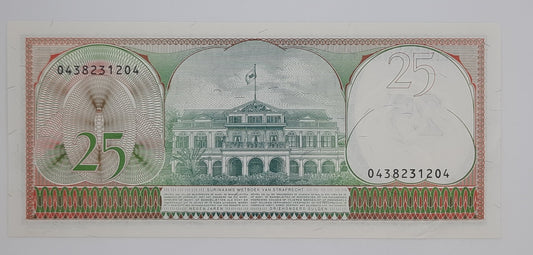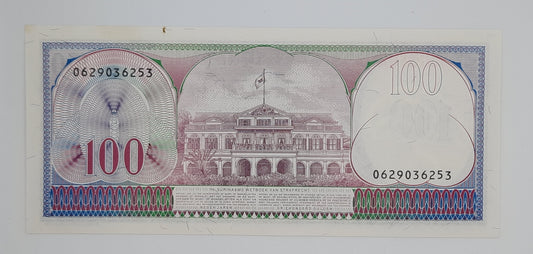Look up Country, Denomination or Year
-
1985 Centrale Bank van Suriname - 25 Gulden Banknote P-127b
Vendor:notescounterRegular price £1.89 GBPRegular priceUnit price / per -
1985 Centrale Bank van Suriname - 100 Gulden Banknote P-128b
Vendor:notescounterRegular price £2.29 GBPRegular priceUnit price / per
Collection: Suriname
Suriname Banknotes – A Journey Through Colonial Legacy and National Identity
Suriname’s banknotes offer a vivid narrative of a nation shaped by colonial heritage, independence, and cultural pride. From early Dutch colonial issues to revolutionary designs of the 1980s and the modern Surinamese dollar, each note reflects a chapter in the country’s evolving identity.
🕰️ Historical Overview:
Pre-1975: As a Dutch colony, Suriname issued banknotes denominated in Surinamese guilders, often printed in the Netherlands and featuring Dutch royal imagery and European design elements.
Post-Independence (1975–2004): The guilder remained in use, but designs shifted to highlight local landmarks, national heroes, and revolutionary symbolism—notably the 1985 100 Gulden note featuring the Monument of the Revolution.
Modern Era (2004–present): The Surinamese dollar (SRD) replaced the guilder at a rate of 1,000:1. New series emphasize biodiversity, indigenous culture, and economic resilience, with vibrant depictions of orchids, birds, and native architecture.
🌿 Themes and Motifs:
Flora & Fauna: Orchids, parrots, and the iconic Pīwakawaka (fantail) bird.
Architecture: The Presidential Palace, colonial buildings, and revolutionary monuments.
Cultural Identity: Traditional tools, musical instruments, and national emblems.
🔍 Collector Highlights:
Pick# 128b (1985 100 Gulden) – A powerful political statement featuring the Monument of the Revolution.
Emergency “Kasplaatjes” (1986) – Rare provisional notes issued during economic crisis.
Decimal Transition Notes – Featuring dual denominations during the switch to the Surinamese dollar.
📚 Catalog References:
Standard Catalog of World Paper Money (Pick numbers)
Numista and Numizon databases for detailed note specifications
Whether you're drawn to post-colonial transitions, Caribbean history, or vivid artistic design, Suriname’s banknotes offer a rich and rewarding collecting experience. Ideal for thematic collectors, educators, and anyone fascinated by the intersection of politics, culture, and currency.



